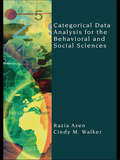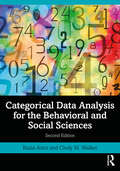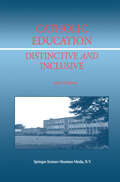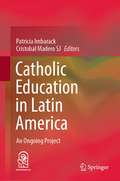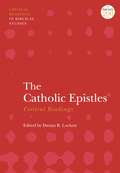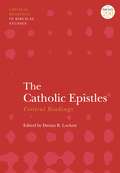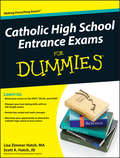- Table View
- List View
Catch that Hat!: Ruby And Merlin: Catch That Hat! (Start Reading: Ruby and Merlin)
by Andy BlackfordIt is such a windy day...Ruby and Merlin are soon helping out their neighbours, but will they catch that hat? Catch That Hat is part of the Ruby and Merlin series; four books at Band 4 of the Start Reading programme.
Catching Readers Before They Fall: Supporting Readers Who Struggle, K-4
by Pat Johnson Katie KeierEvery teacher of reading plays a vital role in helping to catch those readers for whom learning to read does not come easily. Through examples from both adults and children, the authors explain and describe the complex integrated network of strategies that go on in the minds of proficient readersstrategies that struggling readers have to learn in order to construct their own reading processes. This book is essential reading for all who work with struggling readers in any context and contains a wealth of resources, including a thorough explanation of all the sources of information readers use to solve words, examples and scenarios of teacher/student interactions, prompts to use with struggling readers, lessons on modeling, and assessment guidelines.
Catching Readers Before They Fall: Supporting Readers Who Struggle, K-4
by Pat Johnson Katie KeierEvery teacher of reading plays a vital role in helping to catch those readers for whom learning to read does not come easily. Through examples from both adults and children, the authors explain and describe the complex integrated network of strategies that go on in the minds of proficient readersstrategies that struggling readers have to learn in order to construct their own reading processes. This book is essential reading for all who work with struggling readers in any context and contains a wealth of resources, including a thorough explanation of all the sources of information readers use to solve words, examples and scenarios of teacher/student interactions, prompts to use with struggling readers, lessons on modeling, and assessment guidelines.
Catching them at it!: Assessment in the early years (Professional Development)
by Sally FeatherstonePractitioners working within the EYFS are still uncertain of exactly how to manage assessment. This book will take them through the process step by step. It explains the terminology involved, shows practitioners how to turn 'observation' into 'assessment' and in the final chapter sets out how to manage and interpret all the information they have gathered. This book is an essential part of all early years bookshelves as the government expects 80% of the judgements on progress towards the Early Learning Goals to be based on observations of children in 'child-initiated' play environments.
Catching them at it!: Assessment in the early years (Professional Development)
by Sally FeatherstonePractitioners working within the EYFS are still uncertain of exactly how to manage assessment. This book will take them through the process step by step. It explains the terminology involved, shows practitioners how to turn 'observation' into 'assessment' and in the final chapter sets out how to manage and interpret all the information they have gathered. This book is an essential part of all early years bookshelves as the government expects 80% of the judgements on progress towards the Early Learning Goals to be based on observations of children in 'child-initiated' play environments.
Categorical Data Analysis for the Behavioral and Social Sciences
by Razia Azen Cindy M. WalkerFeaturing a practical approach with numerous examples, this book focuses on helping the reader develop a conceptual, rather than technical, understanding of categorical methods, making it a much more accessible text than others on the market. The authors cover common categorical analyses and emphasize specific research questions that can be addressed by each analytic procedure so that readers are able to address the research questions they wish to answer. To achieve this goal, the authors: Review the theoretical implications and assumptions underlying each of the procedures Present each concept in general terms and illustrate each with a practical example Demonstrate the analyses using SPSS and SAS and show the interpretation of the results provided by these programs. A "Look Ahead" section at the beginning of each chapter provides an overview of the material covered so that the reader knows what to expect. This is followed by one or more research questions that can be addressed using the procedure(s) covered in the chapter. A theoretical presentation of the material is provided and illustrated using realistic examples from the behavioral and social sciences. To further enhance accessibility, the new procedures introduced in the book are explicitly related to analytic procedures covered in earlier statistics courses, such as ANOVA and linear regression. Throughout each chapter the authors use practical examples to demonstrate how to obtain and interpret statistical output in both SPSS and SAS. Their emphasis on the relationship between the initial research question, the use of the software to carry out the analysis, and the interpretation of the output as it relates to the initial research question, allows readers to easily apply the material to their own research. The data sets for executing chapter examples using SAS Version 9.1.3 and/or IBM SPSS Version 18 are available on a book specific web site. These data sets and syntax allow readers to quickly run the programs and obtain the appropriate output. The book also includes both conceptual and analytic end-of-chapter exercises to assist instructors and students in evaluating the understanding of the material covered in each chapter. This book covers the most commonly used categorical data analysis procedures. It is written for those without an extensive mathematical background, and is ideal for graduate courses in categorical data analysis or cross-classified data analysis taught in departments of psychology, human development & family studies, sociology, education, and business. Researchers in these disciplines interested in applying these procedures to their own research will appreciate this book’s accessible approach.
Categorical Data Analysis for the Behavioral and Social Sciences
by Razia Azen Cindy M. WalkerFeaturing a practical approach with numerous examples, this book focuses on helping the reader develop a conceptual, rather than technical, understanding of categorical methods, making it a much more accessible text than others on the market. The authors cover common categorical analyses and emphasize specific research questions that can be addressed by each analytic procedure so that readers are able to address the research questions they wish to answer. To achieve this goal, the authors: Review the theoretical implications and assumptions underlying each of the procedures Present each concept in general terms and illustrate each with a practical example Demonstrate the analyses using SPSS and SAS and show the interpretation of the results provided by these programs. A "Look Ahead" section at the beginning of each chapter provides an overview of the material covered so that the reader knows what to expect. This is followed by one or more research questions that can be addressed using the procedure(s) covered in the chapter. A theoretical presentation of the material is provided and illustrated using realistic examples from the behavioral and social sciences. To further enhance accessibility, the new procedures introduced in the book are explicitly related to analytic procedures covered in earlier statistics courses, such as ANOVA and linear regression. Throughout each chapter the authors use practical examples to demonstrate how to obtain and interpret statistical output in both SPSS and SAS. Their emphasis on the relationship between the initial research question, the use of the software to carry out the analysis, and the interpretation of the output as it relates to the initial research question, allows readers to easily apply the material to their own research. The data sets for executing chapter examples using SAS Version 9.1.3 and/or IBM SPSS Version 18 are available on a book specific web site. These data sets and syntax allow readers to quickly run the programs and obtain the appropriate output. The book also includes both conceptual and analytic end-of-chapter exercises to assist instructors and students in evaluating the understanding of the material covered in each chapter. This book covers the most commonly used categorical data analysis procedures. It is written for those without an extensive mathematical background, and is ideal for graduate courses in categorical data analysis or cross-classified data analysis taught in departments of psychology, human development & family studies, sociology, education, and business. Researchers in these disciplines interested in applying these procedures to their own research will appreciate this book’s accessible approach.
Categorical Data Analysis for the Behavioral and Social Sciences
by Razia Azen Cindy M. WalkerFeaturing a practical approach with numerous examples, the second edition of Categorical Data Analysis for the Behavioral and Social Sciences focuses on helping the reader develop a conceptual understanding of categorical methods, making it a much more accessible text than others on the market. The authors cover common categorical analysis methods and emphasize specific research questions that can be addressed by each analytic procedure, including how to obtain results using SPSS, SAS, and R, so that readers are able to address the research questions they wish to answer. Each chapter begins with a "Look Ahead" section to highlight key content. This is followed by an in-depth focus and explanation of the relationship between the initial research question, the use of software to perform the analyses, and how to interpret the output substantively. Included at the end of each chapter are a range of software examples and questions to test knowledge. New to the second edition: The addition of R syntax for all analyses and an update of SPSS and SAS syntax. The addition of a new chapter on GLMMs. Clarification of concepts and ideas that graduate students found confusing, including revised problems at the end of the chapters. Written for those without an extensive mathematical background, this book is ideal for a graduate course in categorical data analysis taught in departments of psychology, educational psychology, human development and family studies, sociology, public health, and business. Researchers in these disciplines interested in applying these procedures will also appreciate this book’s accessible approach.
Categorical Data Analysis for the Behavioral and Social Sciences
by Razia Azen Cindy M. WalkerFeaturing a practical approach with numerous examples, the second edition of Categorical Data Analysis for the Behavioral and Social Sciences focuses on helping the reader develop a conceptual understanding of categorical methods, making it a much more accessible text than others on the market. The authors cover common categorical analysis methods and emphasize specific research questions that can be addressed by each analytic procedure, including how to obtain results using SPSS, SAS, and R, so that readers are able to address the research questions they wish to answer. Each chapter begins with a "Look Ahead" section to highlight key content. This is followed by an in-depth focus and explanation of the relationship between the initial research question, the use of software to perform the analyses, and how to interpret the output substantively. Included at the end of each chapter are a range of software examples and questions to test knowledge. New to the second edition: The addition of R syntax for all analyses and an update of SPSS and SAS syntax. The addition of a new chapter on GLMMs. Clarification of concepts and ideas that graduate students found confusing, including revised problems at the end of the chapters. Written for those without an extensive mathematical background, this book is ideal for a graduate course in categorical data analysis taught in departments of psychology, educational psychology, human development and family studies, sociology, public health, and business. Researchers in these disciplines interested in applying these procedures will also appreciate this book’s accessible approach.
Catherine the Fashion Princess Fairy (Rainbow Magic Early Reader #16)
by Daisy MeadowsCatherine the Fashion Princess Fairy helps make sure princesses everywhere have the perfect outfits for their royal functions. But when Jack Frost and his goblins steal her magical objects, all sorts of things start to go wrong! Can Kirsty and Rachel help get them back before fashion disasters strike the human and fairy worlds?
The Catholic Bible, Personal Study Edition
Informative... Reliable... Accessible First published more than a quarter century ago, The Catholic Bible: Personal Study Edition has long served readers eager for a reliable, accessible guide to lead them into the biblical text. Thumb-indexed for convenience, this third edition is fully revised and augmented with new study aids such as in-text essays on topics that enhance one's reading of the text. The "Reading Guides" that come before the text of the New American Bible Revised Edition -- the translation used in the great majority of U.S. Catholic parishes -- provide a concise, accessible overview of each individual book of the Bible, leading readers through the backgrounds, characters, and messages of all the books and their implications for our lives today. Lay people -- individuals or members of study groups -- students, and general readers will all find essential information in a form that is easy to use and organized for quick reference.
Catholic Christianity in Evolution: The Spiritual Prophecy of Teilhard de Chardin
by Alan SageChristianity, and its theological and spiritual underpinnings, does not fulfil the needs of people living in a rapidly changing world. For all its good intention, the Catholic Church has failed to provide the necessary religious tools to its congregants and wider Catholic community to confront the ecological and environmental problems that confront mankind. This book sets out the required parameters of spirituality within an evolutionary world context, linking the theological with the practical, under the aegis of the Jesuit Pierre Teilhard de Chardin. His writings promote a concept of God at the centre of the world we live in - a Christian way of living, fully engaged. At the heart of Teilhard's world view are creation, evolution, and the environment. He provides the spiritual tools to understand a God that is, in real effect, our evolving world and our actions toward it. In looking after God's world through our daily commitment we meet the needs of the whole of creation. And this makes Christian faith truly meaningful and of direct relevance to our living in the world. Indeed, the second encyclical of Pope Francis (Laudato si') with its care for our common home message, is Teilhardian in its outlook. Likewise the Pope's sacrament of the brother teaching. Because of the inextricable link between human activity and the creative work of God, Teilhard saw all human endeavour as holy. Herewith the Ignatian theme of 'finding God in all things', coupled with a cosmic approach to redemption and the notion of ongoing divine creativity. Teilhard's vision is a template for understanding our place in the world, our intimate relationship to the whole of creation and our responsibilities to the environment and to each other. Teilhard asks us to face the challenges of a rapidly changing world as co-creators with God - a tremendous privilege but also an awesome responsibility. An Appendix lists all of Teilhard's writings and their publication sources, divided into five main sections, and further subdivided by topic - an indispensable resource tool for Teilhard scholars, and for readers familiar with The Divine Milieu and The Human Phenomenon.
Catholic Christianity in Evolution: The Spiritual Prophecy of Teilhard de Chardin
by Alan SageChristianity, and its theological and spiritual underpinnings, does not fulfil the needs of people living in a rapidly changing world. For all its good intention, the Catholic Church has failed to provide the necessary religious tools to its congregants and wider Catholic community to confront the ecological and environmental problems that confront mankind. This book sets out the required parameters of spirituality within an evolutionary world context, linking the theological with the practical, under the aegis of the Jesuit Pierre Teilhard de Chardin. His writings promote a concept of God at the centre of the world we live in - a Christian way of living, fully engaged. At the heart of Teilhard's world view are creation, evolution, and the environment. He provides the spiritual tools to understand a God that is, in real effect, our evolving world and our actions toward it. In looking after God's world through our daily commitment we meet the needs of the whole of creation. And this makes Christian faith truly meaningful and of direct relevance to our living in the world. Indeed, the second encyclical of Pope Francis (Laudato si') with its care for our common home message, is Teilhardian in its outlook. Likewise the Pope's sacrament of the brother teaching. Because of the inextricable link between human activity and the creative work of God, Teilhard saw all human endeavour as holy. Herewith the Ignatian theme of 'finding God in all things', coupled with a cosmic approach to redemption and the notion of ongoing divine creativity. Teilhard's vision is a template for understanding our place in the world, our intimate relationship to the whole of creation and our responsibilities to the environment and to each other. Teilhard asks us to face the challenges of a rapidly changing world as co-creators with God - a tremendous privilege but also an awesome responsibility. An Appendix lists all of Teilhard's writings and their publication sources, divided into five main sections, and further subdivided by topic - an indispensable resource tool for Teilhard scholars, and for readers familiar with The Divine Milieu and The Human Phenomenon.
Catholic Education: Distinctive and Inclusive
by J. SullivanHow coherent is the claim that Catholic education is both distinctive and inclusive? This question, so crucial, both for the adequate articulation of a raison d'être for Catholic schools all over the world and also for the promotion of their healthy functioning, has not hitherto been addressed critically. Here it receives penetrating analysis and constructive resolution in a comprehensive treatment that integrates theological, philosophical and educational perspectives. The argument draws on wide-ranging scholarship, offering new insights into the relevance for Catholic education of thinkers whose work has been relatively neglected. The advance in understanding of how distinctiveness relates to inclusiveness is underpinned by the author's lengthy experience of teaching and leadership in Catholic schools; it is further informed by his extended and continuing dialogue with Catholic educators at all levels and in many different countries.
Catholic Education in Latin America: An Ongoing Project
by Patricia Imbarack Cristobal Madero SjThis book aims to be a reference for understanding an educational system throughout Latin America aligned with the Catholic Church. In both public and private sectors, whether it’s in the secular or the religious sector, considering Catholic Education brings up a question regarding the relevance of religion in the public sector, where education is presented as another alternative of education. This volume allows the reader to take a closer look into the recent challenges of Catholic Education in Latin America, such as quality and excellence, its anthropological dimension, as well as the ongoing dialogue between faith and culture. These essential elements are reflected upon, developing an educational process that responds to the current needs. Deep reflection is made in a contemporary and regional context throughout the eleven chapters of this book, all written by Latin American authors. Translation from the Spanish language edition: EDUCACIÓN CATÓLICA EN LATINOAMÉRICA. Un proyecto en marcha by Patricia Imbarack and Cristóbal Madero © Ediciones Universidad Católica de Chile, 2019. Original Publication ISBN 978-956-14-2459-3. All rights reserved
The Catholic Epistles: The Formation Of The Catholic Epistles As A Canonical Collection (T&T Clark Critical Readings in Biblical Studies)
by Darian R. LockettThis reference volume aims to be a kind of comprehensive status quaestionis for the Catholic Epistles. Here Darian Lockett has collected some of the highest quality scholarship concentred upon the Letters of James, Peter, ohn, and Jude, creating an introduction and orientation to the wide ranging avenues of scholarly investigation into these New Testament texts all in a single-volume.Divided into four distinct sections, the volume begins with an analysis of the Catholic Epistles as a collection, before moving to discuss historical-critical and theological studies, methodological approaches, and, finally, reception history. Taking care to situate foundational essays in the history of scholarship that may be hard to find or contextualize, Lockett offers a brief introduction to each section and draws each section to a close by providing a list of annotated readings which prompt further study and engagement with some of the last literature to be settled upon in the New Testament canon.
The Catholic Epistles: Critical Readings (T&T Clark Critical Readings in Biblical Studies)
This reference volume aims to be a kind of comprehensive status quaestionis for the Catholic Epistles. Here Darian Lockett has collected some of the highest quality scholarship concentred upon the Letters of James, Peter, ohn, and Jude, creating an introduction and orientation to the wide ranging avenues of scholarly investigation into these New Testament texts all in a single-volume.Divided into four distinct sections, the volume begins with an analysis of the Catholic Epistles as a collection, before moving to discuss historical-critical and theological studies, methodological approaches, and, finally, reception history. Taking care to situate foundational essays in the history of scholarship that may be hard to find or contextualize, Lockett offers a brief introduction to each section and draws each section to a close by providing a list of annotated readings which prompt further study and engagement with some of the last literature to be settled upon in the New Testament canon.
Catholic High School Entrance Exams For Dummies
by Lisa Zimmer Hatch Scott A. HatchA real-world guide to passing the entrance exam for Catholic high school Catholic High School Entrance Exams For Dummies provides students and their parents with an efficient and effective way to prepare for the HSPT, TACHS, and COOP-the three entrance exams used by Catholic high schools. Included are Six full-length practice tests Test-taking tips from the experts Thorough reviews of each test's format With full sample tests, up-to-date questions, and a comprehensive review of the basics in each category, Catholic High School Entrance Exams For Dummies is a family's ticket to education success.
Catholic High School Entrance Exams For Dummies
by Lisa Zimmer Hatch Scott A. HatchA real-world guide to passing the entrance exam for Catholic high school Catholic High School Entrance Exams For Dummies provides students and their parents with an efficient and effective way to prepare for the HSPT, TACHS, and COOP-the three entrance exams used by Catholic high schools. Included are Six full-length practice tests Test-taking tips from the experts Thorough reviews of each test's format With full sample tests, up-to-date questions, and a comprehensive review of the basics in each category, Catholic High School Entrance Exams For Dummies is a family's ticket to education success.
Catholic High Schools: Facing the New Realities
by James L. HeftCatholic high schools in the United States have been undergoing three major changes: the shift to primarily lay leadership and teachers; the transition to a more consumerist and pluralist culture; and the increasing diversity of students attending Catholic high schools. James Heft argues that to navigate these changes successfully, leaders of Catholic education need to inform lay teachers more thoroughly, conduct a more profound social analysis of the culture, and address the real needs of students. After presenting the history of Catholic schools in the United States and describing the major legal decisions that have influenced their evolution, Heft describes the distinctive and compelling mission of a Catholic high school. Two chapters are devoted to leadership, and other chapters to teachers, students, alternative models of high schools, financing, and the key role of parents, who today may be described as ''post-deferential'' to traditional authorities, including bishops and priests. Written by an award-winning teacher, scholar, and recognized educational leader in Catholic education, Catholic High Schools should be read by everyone interested in religiously- affiliated educational institutions, particularly Catholic education.
Catholic High Schools: Facing the New Realities
by James L. HeftCatholic high schools in the United States have been undergoing three major changes: the shift to primarily lay leadership and teachers; the transition to a more consumerist and pluralist culture; and the increasing diversity of students attending Catholic high schools. James Heft argues that to navigate these changes successfully, leaders of Catholic education need to inform lay teachers more thoroughly, conduct a more profound social analysis of the culture, and address the real needs of students. After presenting the history of Catholic schools in the United States and describing the major legal decisions that have influenced their evolution, Heft describes the distinctive and compelling mission of a Catholic high school. Two chapters are devoted to leadership, and other chapters to teachers, students, alternative models of high schools, financing, and the key role of parents, who today may be described as ''post-deferential'' to traditional authorities, including bishops and priests. Written by an award-winning teacher, scholar, and recognized educational leader in Catholic education, Catholic High Schools should be read by everyone interested in religiously- affiliated educational institutions, particularly Catholic education.
Catholic High Schools and Minority Students
by Andrew M. GreeleyThe number of minority students, many of them not Catholic, who have enrolled in Catholic secondary schools is substantial. Since it is reasonable to assume that the cost of tuition in such schools is considerable for a minority family, the phenomenon suggests that parents in these families believe that their children will obtain a better education in Catholic secondary schools. The problem of measuring the effect of Catholic secondary schools on minority students is difficult because it is a complex and intricate task to separate family background and student motivation as influences on academic performance from the school's contribution. Here, Andrew M. Greeley makes the case that the burden of proof rests on those who contend that family and student motivation are more important than the character of the school. Using a complex analytic technique that includes sophisticated mathematical models, Greeley demonstrates that the preponderance of evidence tilts in favor of the school. There appears to be an authentic Catholic school effect, attributable to religious order ownership of some schools, more regular discipline in the schools, and especially to a higher quality of teaching in such schools. The effect of Catholic secondary schools on minority students does not occur among students from well-educated families who have been successful in their previous education experiences, but rather among students disadvantaged by race, the fact that their parents did not attend college, and by their own previous educational experiences. As these schools were originally established at the beginning of the twentieth century to socialize the children of the urban poor, their present success with today's urban poor may be due to the fact that these schools are simply doing what they have always done. In a preface written for this new, paperback edition of Catholic High Schools and Minority Students, Greeley confirms the continued success of Catholic schools based on
Catholic High Schools and Minority Students
by Andrew M. GreeleyThe number of minority students, many of them not Catholic, who have enrolled in Catholic secondary schools is substantial. Since it is reasonable to assume that the cost of tuition in such schools is considerable for a minority family, the phenomenon suggests that parents in these families believe that their children will obtain a better education in Catholic secondary schools. The problem of measuring the effect of Catholic secondary schools on minority students is difficult because it is a complex and intricate task to separate family background and student motivation as influences on academic performance from the school's contribution. Here, Andrew M. Greeley makes the case that the burden of proof rests on those who contend that family and student motivation are more important than the character of the school. Using a complex analytic technique that includes sophisticated mathematical models, Greeley demonstrates that the preponderance of evidence tilts in favor of the school. There appears to be an authentic Catholic school effect, attributable to religious order ownership of some schools, more regular discipline in the schools, and especially to a higher quality of teaching in such schools. The effect of Catholic secondary schools on minority students does not occur among students from well-educated families who have been successful in their previous education experiences, but rather among students disadvantaged by race, the fact that their parents did not attend college, and by their own previous educational experiences. As these schools were originally established at the beginning of the twentieth century to socialize the children of the urban poor, their present success with today's urban poor may be due to the fact that these schools are simply doing what they have always done. In a preface written for this new, paperback edition of Catholic High Schools and Minority Students, Greeley confirms the continued success of Catholic schools based on
Catholic Higher Education: A Culture in Crisis
by Melanie M. Morey John J. PideritCatholic higher education in the United States is undergoing dramatic changes, driven largely by the virtual disappearance of nuns, brothers, and priests from Catholic university campuses. Today Catholic colleges and universities are dealing with critical questions about what constitutes Catholic collegiate identity. What are appropriate ways to engage the Catholic tradition across all sectors of university life? What constitutes a critical mass of committed and knowledgeable Catholics necessary to maintain religious identity? What is an appropriate level of knowledge and religious commitment for those who lead, govern, and teach at Catholic institutions and how do they acquire it? Many people have strong - and strongly differing - opinions about the current state of Catholic higher education. Melanie M. Morey and John J. Piderit, S.J., wade into these waters with a study of 124 senior administrators at 33 Catholic colleges and universities across the United States. Exceptionally candid appraisals by administrators across a varied landscape attest that a cultural crisis is looming at a number of Catholic institutions. Based on their research, Morey and Piderit describe the present situation and offer concrete suggestions for enhancing Catholic identity, culture, and mission at all Catholic colleges and universities. The authors define the critical issues and analyze and address them by using the rich construct of culture, particularly organizational culture. They provide four different models of how Catholic colleges and universities can operate and successfully compete as religiously distinctive institutions in the higher education market. After identifying the content of the Catholic tradition - intellectual, moral, and social - the authors analyze present performance among institutions in all four models. They derive criteria for identifying religious cultural crisis at institutions and provide specific policy proposals for enhancing religious culture. They also suggest principles for effectively leading and managing cultural change. Morey and Piderit offer the first in-depth cultural analysis of the Catholic character of Catholic universities and colleges at a crucial time for these institutions. With new research and practical applications, this book is an invaluable resource for Catholic educators and anyone concerned about the future of Catholic higher education.
Catholic Higher Education: A Culture in Crisis
by Melanie M. Morey John J. PideritCatholic higher education in the United States is undergoing dramatic changes, driven largely by the virtual disappearance of nuns, brothers, and priests from Catholic university campuses. Today Catholic colleges and universities are dealing with critical questions about what constitutes Catholic collegiate identity. What are appropriate ways to engage the Catholic tradition across all sectors of university life? What constitutes a critical mass of committed and knowledgeable Catholics necessary to maintain religious identity? What is an appropriate level of knowledge and religious commitment for those who lead, govern, and teach at Catholic institutions and how do they acquire it? Many people have strong - and strongly differing - opinions about the current state of Catholic higher education. Melanie M. Morey and John J. Piderit, S.J., wade into these waters with a study of 124 senior administrators at 33 Catholic colleges and universities across the United States. Exceptionally candid appraisals by administrators across a varied landscape attest that a cultural crisis is looming at a number of Catholic institutions. Based on their research, Morey and Piderit describe the present situation and offer concrete suggestions for enhancing Catholic identity, culture, and mission at all Catholic colleges and universities. The authors define the critical issues and analyze and address them by using the rich construct of culture, particularly organizational culture. They provide four different models of how Catholic colleges and universities can operate and successfully compete as religiously distinctive institutions in the higher education market. After identifying the content of the Catholic tradition - intellectual, moral, and social - the authors analyze present performance among institutions in all four models. They derive criteria for identifying religious cultural crisis at institutions and provide specific policy proposals for enhancing religious culture. They also suggest principles for effectively leading and managing cultural change. Morey and Piderit offer the first in-depth cultural analysis of the Catholic character of Catholic universities and colleges at a crucial time for these institutions. With new research and practical applications, this book is an invaluable resource for Catholic educators and anyone concerned about the future of Catholic higher education.




